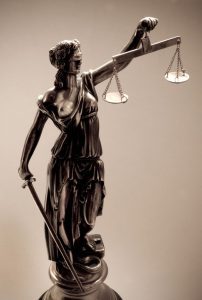If you want to see an allegorical personification, or a person based off of human psychology, of justice, you will be presented an image of Lady Justice in front of you. She is known as the Roman goddess of Justice (as Justita) and is equivalent to Themis, a Greek goddess who is described as “[the Lady] of good counsel”. Lady Justice can also be traced as far back as the ancient Egyptians goddess Isis and Maat. She was first sculpted with her blindfold by Hans Gieng, a Renaissance sculptor, in the late 15th century. The blindfolded Lady Justice represents a theory in law: blind justice.
Blind Justice is a theory the law should be determined guilty or not guilty with an open mind and without any bias or prejudice. The Supreme Court motto is “Equal Justice Under Law”. With this belief, the Supreme Court justice takes the following oath:
“I, [name], do solemnly swear [or affirm] that I will administer justice without respect to persons, and do equal right to the poor and to the rich, and that I will faithfully and impartially discharge and perform all the duties incumbent upon me as [title] under the Constitution and laws of the United States. So help me God.”
Some sculptors though leave her blindfold off and create her with a scale in one hand and a sword in the other. Some courthouses leave her blindfold off due to the fact she was originally not blindfolded. Others believe that the blindfold is redundant to her sword and scale and that her “maidenly form” guarantees her impartiality. The scale represents justice that is well balanced and fair while the sword represents the power and strength of justice.
Lady Justice, with or without her blindfold, is a symbol to all on how the court system tries to be fair and grant everyone with a fair trial beyond prejudice and bias. May she continue to raise her sword, make her scale balanced, and continue to be blind to any sort of bias or prejudice to this day.

